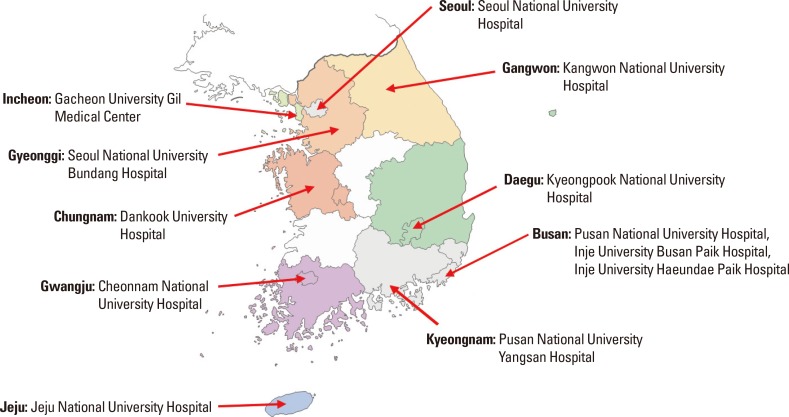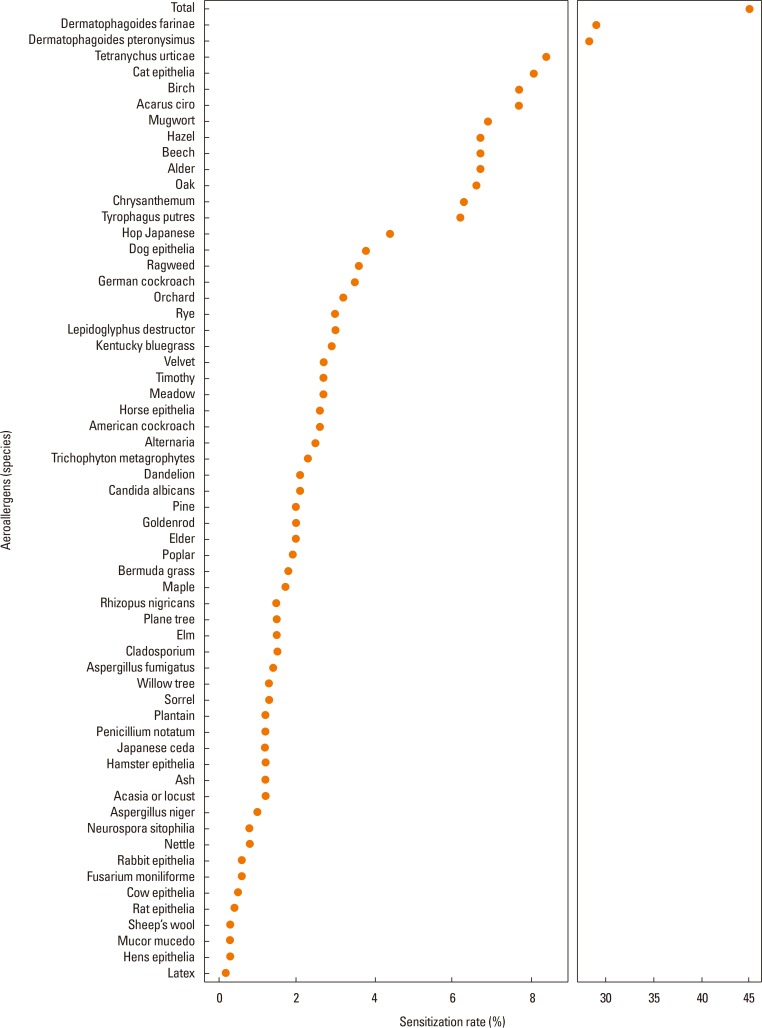Patterns of Inhalant Allergen Sensitization and Geographical Variation in Korean Adults: A Multicenter Retrospective Study
- Affiliations
-
- 1Institute of Allergy and Clinical Immunology, Seoul National University Medical Research Center, Seoul, Korea. shcho@plaza.snu.ac.kr
- 2Department of Internal Medicine, Chungbuk National University Hospital, Cheongju, Korea.
- 3Department of Internal Medicine, Busan Paik Hospital, Inje University College of Medicine, Busan, Korea.
- 4Department of Internal Medicine, Seoul National University College of Medicine, Seoul, Korea.
- 5Department of Internal Medicine, Kyungpook National University School of Medicine, Daegu, Korea.
- 6Department of Internal Medicine, Pusan National University Hospital, Busan, Korea.
- 7Department of Internal Medicine, Pusan National University Yangsan Hospital, Yangsan, Korea.
- 8Department of Internal Medicine, Kangwon National University School of Medicine, Chuncheon, Korea.
- 9Department of Internal Medicine, Gacheon University Gil Medical Center, Incheon, Korea.
- 10Department of Internal Medicine, Haeundae Paik Hospital, Inje University College of Medicine, Busan, Korea.
- 11Department of Internal Medicine, Seoul National University Bundang Hospital, Seongnam, Korea.
- 12Department of Internal Medicine, Jeju National University School of Medicine, Jeju, Korea.
- 13Department of Internal Medicine, Dankook University College of Medicine, Cheonan, Korea.
- 14Department of Internal Medicine, Cheonnam National University Hospital, Gwangju, Korea.
- KMID: 2421660
- DOI: http://doi.org/10.4168/aair.2017.9.6.499
Abstract
- PURPOSE
Inhalant allergen sensitization is one of the major factors involved in the pathogenesis of allergic respiratory diseases. However, the sensitization is determined by interactions between genetic and environmental factors. Thus, testing panels of inhalant allergens may differ among geographical areas. Here we aimed to determine 10 common inhalant allergens in Korean adult patients with suspected respiratory allergies and to examine the variation between different geographical locations.
METHODS
A total of 28,954 patient records were retrieved for retrospective analysis, from 12 referral allergy clinics located in 9 different areas. Inclusion criteria were Korean adults (≥18 years old) who underwent the inhalant allergen skin prick test for suspected history of respiratory allergy. The primary outcome was inhalant allergen skin prick response. Demographic and clinical information were also collected. Positive skin prick responses to allergens were defined as allergen-to-histamine wheal ratio ≥1. Based on skin test results, the most prevalent aeroallergens were determined.
RESULTS
The overall prevalence of allergic sensitization was 45.3%. Dermatophagoides farinae and Dermatophagoides pteronyssinus were the most commonly sensitized allergens. Other common inhalant allergens were cat epithelium (8.1%), birch (7.7%), mugwort (6.9%), alder (6.7%), hazel (6.7%), beech (6.7%), oak (6.6%), and Tyrophagus putres (6.2%), in decreasing order frequency. These 10 inhalant allergens explained 90% of inhalant allergen sensitization in the study participants. However, distinct patterns of the 10 inhalant sensitization were observed in patients living in Chungnam and Jeju. American cockroach, Gernam cockroach, and Trichophyton metagrophytes were unique in Chungnam. Orchard, Japanese cedar, and Velvet were unique in Jeju.
CONCLUSIONS
The present analysis suggests a panel of 10 most common inhalant allergens in Korean adult patients with suspected respiratory allergies, which explained 90% of inhalant allergen sensitization. This panel can be utilized as a practical and convenient tool for primary practice and epidemiological surveys of respiratory allergic diseases.
Keyword
MeSH Terms
Figure
Cited by 5 articles
-
Safety and Utility of Rush Immunotherapy with Aqueous Allergen Extracts for Treatment of Respiratory Allergies
Ji-Ho Lee, Jae-Hwa Choi, Keun-Bae Jeong, Seok Jeong Lee, Myoung Kyu Lee, Won-Yeon Lee, Suk Joong Yong, Sang-Ha Kim
J Korean Med Sci. 2020;36(3):e18. doi: 10.3346/jkms.2021.36.e18.House Dust Mite Allergy Under Changing Environments
Nathalie Acevedo, Josefina Zakzuk, Luis Caraballo
Allergy Asthma Immunol Res. 2019;11(4):450-469. doi: 10.4168/aair.2019.11.4.450.Spring and allergy
Yoon-Seok Chang
Asia Pac Allergy. 2018;8(2):. doi: 10.5415/apallergy.2018.8.e22.Optimization of Allergen Panels for Diagnosis of Allergic Rhinitis
Jieun Lee, Jin Kook Kim, Kyung Soo Kim, Chae-Seo Rhee
Korean J Otorhinolaryngol-Head Neck Surg. 2019;62(11):609-616. doi: 10.3342/kjorl-hns.2019.00451.Cluster Analysis of Inhalant Allergens in South Korea: A Computational Model of Allergic Sensitization
Dong-Kyu Kim, Young-Sun Park, Kyung-Joon Cha, Daeil Jang, Seungho Ryu, Kyung Rae Kim, Sang-Heon Kim, Ho Joo Yoon, Seok Hyun Cho
Clin Exp Otorhinolaryngol. 2021;14(1):93-99. doi: 10.21053/ceo.2019.01921.
Reference
-
1. Newson RB, van Ree R, Forsberg B, Janson C, Lötvall J, Dahlén SE, et al. Geographical variation in the prevalence of sensitization to common aeroallergens in adults: the GA(2) LEN survey. Allergy. 2014; 69:643–651. PMID: 24654915.2. Chan-Yeung M, Anthonisen NR, Becklake MR, Bowie D, Sonia Buist A, Dimich-Ward H, et al. Geographical variations in the prevalence of atopic sensitization in six study sites across Canada. Allergy. 2010; 65:1404–1413. PMID: 20557300.
Article3. Salo PM, Arbes SJ Jr, Jaramillo R, Calatroni A, Weir CH, Sever ML, et al. Prevalence of allergic sensitization in the United States: results from the National Health and Nutrition Examination Survey (NHANES) 2005–2006. J Allergy Clin Immunol. 2014; 134:350–359. PMID: 24522093.
Article4. Kim TB, Kim KM, Kim SH, Kang HR, Chang YS, Kim CW, et al. Sensitization rates for inhalant allergens in Korea; a multi-center study. J Asthma Allergy Clin Immunol. 2003; 23:483–493.5. Kim YK, Kim SH, Tak YJ, Jee YK, Lee BJ, Kim SH, et al. High prevalence of current asthma and active smoking effect among the elderly. Clin Exp Allergy. 2002; 32:1706–1712. PMID: 12653160.
Article6. Song WJ, Kim SH, Lim S, Park YJ, Kim MH, Lee SM, et al. Association between obesity and asthma in the elderly population: potential roles of abdominal subcutaneous adiposity and sarcopenia. Ann Allergy Asthma Immunol. 2012; 109:243–248. PMID: 23010229.
Article7. Song WJ, Chang YS, Lim MK, Yun EH, Kim SH, Kang HR, et al. Staphylococcal enterotoxin sensitization in a community-based population: a potential role in adult-onset asthma. Clin Exp Allergy. 2014; 44:553–562. PMID: 24444125.
Article8. Park HJ, Lim HS, Park KH, Lee JH, Park JW, Hong CS. Changes in allergen sensitization over the last 30 years in Korea respiratory allergic patients: a single-center. Allergy Asthma Immunol Res. 2014; 6:434–443. PMID: 25229001.
Article9. Park HJ, Lee JH, Park KH, Ann HW, Jin MN, Choi SY, et al. A nationwide survey of inhalant allergens sensitization and levels of indoor major allergens in Korea. Allergy Asthma Immunol Res. 2014; 6:222–227. PMID: 24843797.
Article10. Lee JE, Ahn JC, Han DH, Kim DY, Kim JW, Cho SH, et al. Variability of offending allergens of allergic rhinitis according to age: optimization of skin prick test allergens. Allergy Asthma Immunol Res. 2014; 6:47–54. PMID: 24404393.
Article11. Jung JW, Choi JC, Shin JW, Kim JY, Park IW, Choi BW. Clinical characteristics according to sensitized allergens in adult korean patients with bronchial asthma. Allergy Asthma Immunol Res. 2010; 2:102–107. PMID: 20358023.
Article12. Adinoff AD, Rosloniec DM, McCall LL, Nelson HS. Immediate skin test reactivity to Food and Drug Administration-approved standardized extracts. J Allergy Clin Immunol. 1990; 86:766–774. PMID: 2229841.
Article13. Neyeloff JL, Fuchs SC, Moreira LB. Meta-analyses and Forest plots using a microsoft excel spreadsheet: step-by-step guide focusing on descriptive data analysis. BMC Res Notes. 2012; 5:52. PMID: 22264277.
Article14. Statistics Korea. 2010 Population and housing census. Daejeon: Statistics Korea;2011.15. Lee J, Lee KH, Lee HS, Hong SC, Kim JH. Japanese cedar (Cryptomeria japonica) pollinosis in Jeju, Korea: is it increasing? Allergy Asthma Immunol Res. 2015; 7:295–300. PMID: 25749782.
Article16. Kim YJ, Han JE, Kang IJ. Change of inhalant allergen sensitization in children with allergic respiratory diseases during recent 10 years. Korean J Asthma Allergy Clin Immunol. 2004; 24:241–246.17. Lee JJ, Lee KH, Kim JH. Japanese cedar (Cryptomeria japonica) pollinosis in Jeju, Korea; might it be increasing? J Allergy Clin Immunol. 2015; 135:AB108.
Article18. Oh JW, Lee HB, Kang IJ, Kim SW, Park KS, Kook MH, et al. The revised edition of Korean calendar for allergenic pollens. Allergy Asthma Immunol Res. 2012; 4:5–11. PMID: 22211164.
Article19. Jeon BH, Lee J, Kim JH, Kim JW, Lee HS, Lee KH. Atopy and sensitization rates to aeroallergens in children and teenagers in Jeju, Korea. Korean J Asthma Allergy Clin Immunol. 2010; 30:14–20.
- Full Text Links
- Actions
-
Cited
- CITED
-
- Close
- Share
- Similar articles
-
- Comparison of inhalant allergen sensitization between children, adolescents, and adults with asthma and allergic rhinitis
- Change of Inhalant Allergen Sensitization in Children with Allergic Respiratory Diseases during Recent 10 Years
- Blood eosinophil counts as a biomarker for allergen sensitization in childhood allergic diseases in comparison with total IgE
- A comparison of Sensitization to Major Indoor & Outdoor Inhalant Allergens in Children with Respiratory Allergic Diseases
- Cluster Analysis of Inhalant Allergens in South Korea: A Computational Model of Allergic Sensitization



